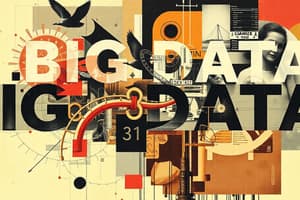Podcast
Questions and Answers
What type of analysis focuses on summarizing and describing a dataset?
What type of analysis focuses on summarizing and describing a dataset?
- Inferential analysis
- Predictive analysis
- Comparative analysis
- Descriptive analysis (correct)
Which data source is specifically mentioned as providing access to reports and interactive tools for data analysis?
Which data source is specifically mentioned as providing access to reports and interactive tools for data analysis?
- INE (correct)
- Ministry of Economy, Trade and Enterprise
- National Bureau of Statistics
- Local Government Statistics Office
Trend analysis can be effectively used to analyze changes over what timeframe?
Trend analysis can be effectively used to analyze changes over what timeframe?
- A single day
- A limited time period
- The previous decade
- Over intervals, such as months or years (correct)
Which of the following is NOT a type of analysis mentioned in the content?
Which of the following is NOT a type of analysis mentioned in the content?
What type of data does the Ministry of Economy, Trade and Enterprise focus on?
What type of data does the Ministry of Economy, Trade and Enterprise focus on?
What was introduced in the 1970s as a standard tool for database design?
What was introduced in the 1970s as a standard tool for database design?
Which database technology allows the management of unstructured data, such as images and text, as per its development timeline?
Which database technology allows the management of unstructured data, such as images and text, as per its development timeline?
What is a common limitation of older information storage methods like paper and magnetic tapes?
What is a common limitation of older information storage methods like paper and magnetic tapes?
Which of the following statements is true regarding database technology advancements in the 1980s?
Which of the following statements is true regarding database technology advancements in the 1980s?
What was a significant development in data management during the 2000s?
What was a significant development in data management during the 2000s?
Which international organization provides access to macroeconomic and financial data?
Which international organization provides access to macroeconomic and financial data?
What is the primary advantage of using databases over traditional data management methods?
What is the primary advantage of using databases over traditional data management methods?
Which of the following best describes a foreign key?
Which of the following best describes a foreign key?
What advantage does SQL provide for data analysis?
What advantage does SQL provide for data analysis?
Which data type would be appropriate for storing a precise monetary value?
Which data type would be appropriate for storing a precise monetary value?
In SQL, what is the primary purpose of indexes?
In SQL, what is the primary purpose of indexes?
What does the BOOLEAN data type represent in SQL?
What does the BOOLEAN data type represent in SQL?
Which command is used to remove a table from a database?
Which command is used to remove a table from a database?
What type of data is suitable for use with the CHAR(n) data type?
What type of data is suitable for use with the CHAR(n) data type?
How does SQL support business intelligence?
How does SQL support business intelligence?
Which statement about relational databases is false?
Which statement about relational databases is false?
What does the INNER JOIN clause specifically return?
What does the INNER JOIN clause specifically return?
What is the correct syntax to delete records from a table?
What is the correct syntax to delete records from a table?
Which SQL statement is used to change existing data in a database table?
Which SQL statement is used to change existing data in a database table?
Which SQL clause allows you to filter results based on specified conditions?
Which SQL clause allows you to filter results based on specified conditions?
What is the outcome of a LEFT OUTER JOIN when no match is found?
What is the outcome of a LEFT OUTER JOIN when no match is found?
Which SQL command is used to add a new column to an existing table?
Which SQL command is used to add a new column to an existing table?
To summarize data with a count of all records in a table, which SQL statement would you use?
To summarize data with a count of all records in a table, which SQL statement would you use?
What is the purpose of SQL operators in data queries?
What is the purpose of SQL operators in data queries?
When should the DROP TABLE command be used?
When should the DROP TABLE command be used?
Flashcards are hidden until you start studying
Study Notes
Big Data
- Data is crucial for decision-making in all business areas
- By 2025, the world will generate 175 zettabytes (ZB) of data. In 2010 it was just 2ZB
- 90% of data were generated in the last 2 years
- Daily, internet users generate roughly 2,5 million gigabytes of data
- Key characteristics of big data are velocity, variety, volume, veracity and value
The 5 Vs of Big Data
- Velocity: Data gathered in real-time, near-real-time, batch, and streams
- Variety: Structured, semi-structured, and unstructured data
- Volume: Massive amounts of data including terabytes or petabytes
- Veracity: Trustworthiness, authenticity, source, reputation and accountability
- Value: Statistical methods, correlations, and hypothetical relations
Data Sources
- Main sources include Facebook, Twitter, Instagram, and the Internet of Things (IoT).
- Twitter averages 500,000 tweets per minute
- Instagram averages 347,222 posts per minute
- IoT devices generate data from 75 million connected devices.
Data Storage
- Less than 20% of data is stored in relational databases
- 80% is unstructured (text, images, video)
- Big Data storage utilizes Big Data Architectures, cloud storage, and NoSQL databases
- Modern storage solutions are needed because traditional database methods can't handle the volume of data
Data Analysis Methods
- Descriptive Analysis: Summarizing and describing datasets (e.g., unemployment rates)
- Trend Analysis: Analyzing how data changes over time (e.g., how employment changes monthly)
- Comparative Analysis: Analyzing differences between groups, regions, or variables (e.g., comparing unemployment rates across different Spanish communities)
Economic and Financial Data Sources
- Government entities like the INE (National Statistics Institute) provide statistical data on economics, demographics, and social aspects of a country
- Other sources include the Demography and population, economy, labor market, and companies and establishments statistics.
- The Spanish Ministry of Economy, Trade and Enterprise provides macroeconomic, public finance, labor market, financial system, and foreign trade statistics
Additional Data Sources
- Spanish Government
- Madrid Stock Market
- Spanish Bank
- Eurostat
- World Bank
- International Monetary Fund
Introduction to Databases
- Databases are crucial in today's digital world, facilitating efficient data management across industries like e-commerce, social media, banking and healthcare
- Before databases, data was stored on paper, magnetic tapes in books/files, electronic files and directories
- These older methods lacked integrity, security and inability to handle large volumes of data
- The Entity-Relationship model in the 1970s was standardized for managing databases
- Relational Database Management System (RDBMS) emerged with Oracle and eventually Microsoft SQL Server becoming standards
- 1990s led to NoSQL/Data mining and open-source databases with Big Data and cloud computing
Basic Concepts of Databases
- A database is a structured collection of interrelated data
- It is composed of tables with rows and columns where the data is stored
- Data can relate to people, products, orders and more
- Databases started as simple spreadsheets that evolved into complex organizations
Database Management Systems (DBMS)
- Software to handle creation, retrieval, updating, and maintenance of databases
- Interfaces between users and the database, ensuring data integrity and security
- Common DBMSs include Oracle Database, Microsoft SQL Server, and MySQL
SQL
- Structured Query Language (SQL) is a standardized language for managing and manipulating data in relational databases
- Handles large data volumes efficiently and is easy to learn
Data Types
- Different data types exist for storing various kinds of data (integers/characters, dates, large amounts of text, floating point numbers etc)
Data Analysis in Databases
- Database analysis use aggregations and filtering to derive insights
- Aggregation includes calculations like sums, average, counts, maximum or minimum values etc
- Filtering conditions allow data selection using criteria (e.g., select customers that order more than twice etc)
- Subqueries can be used in queries for more complex filtering, calculation, or results extraction
Database Design
- The process of defining data structures, storage mechanisms, and retrieval methods in a database system
- Crucial for efficiently storing, accessing and managing data
- Important factors that are included are schemes, normalization, physical implementation, and performance optimization
Excel as a Database Tool
- Excel serves as a flat-file database for small datasets, lacking complex relational structures found in SQL databases.
- Relationships between tables can be established and queries can be performed
NoSQL Databases
- Designed for large datasets and flexible schemas
- NoSQL databases come in different models (document stores, key-value stores, graph databases)
- They are good for storing and managing non-tabular data types such as images and social media feeds
PowerBI tools for Databases
- Provides a user-friendly interface, allowing both technical and non-technical users to interact with underlying data sources
- Supports report building and data visualization, and can query and analyze data from multiple sources
- Used for exploratory analysis and visualization rather than being a primary storage tool like SQL databases
Studying That Suits You
Use AI to generate personalized quizzes and flashcards to suit your learning preferences.
Related Documents
Description
Explore the essential aspects of big data, including its significance in decision-making across various business sectors. Learn about the five key characteristics of big data, known as the 5 Vs: velocity, variety, volume, veracity, and value, and understand the sources generating vast amounts of data daily.




